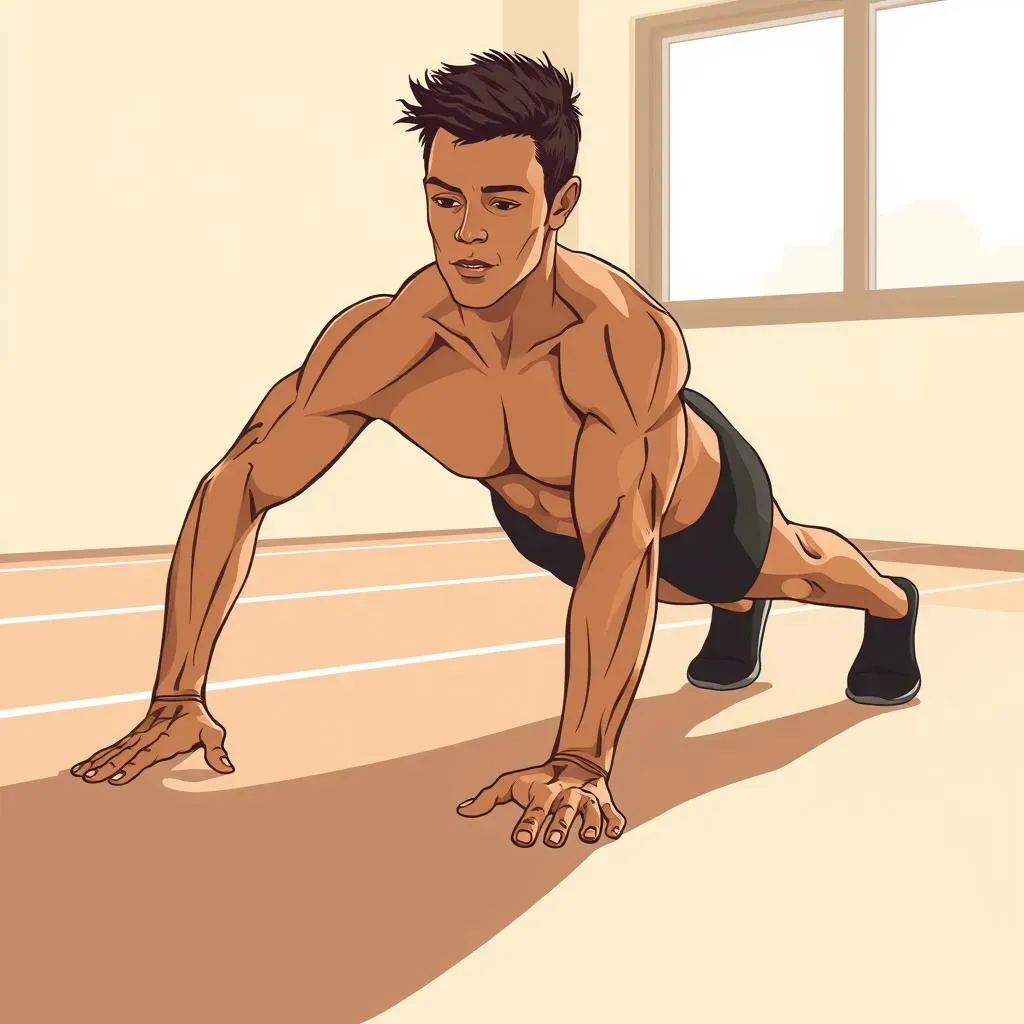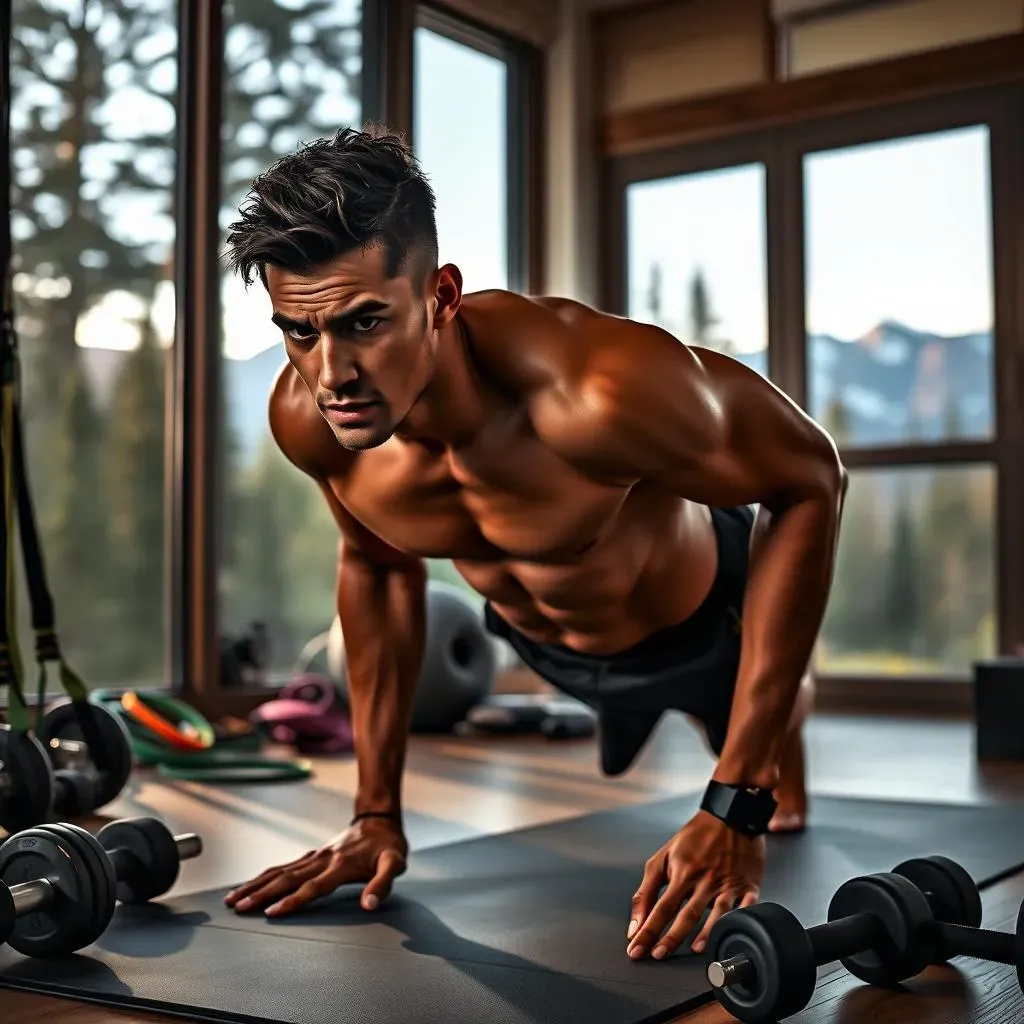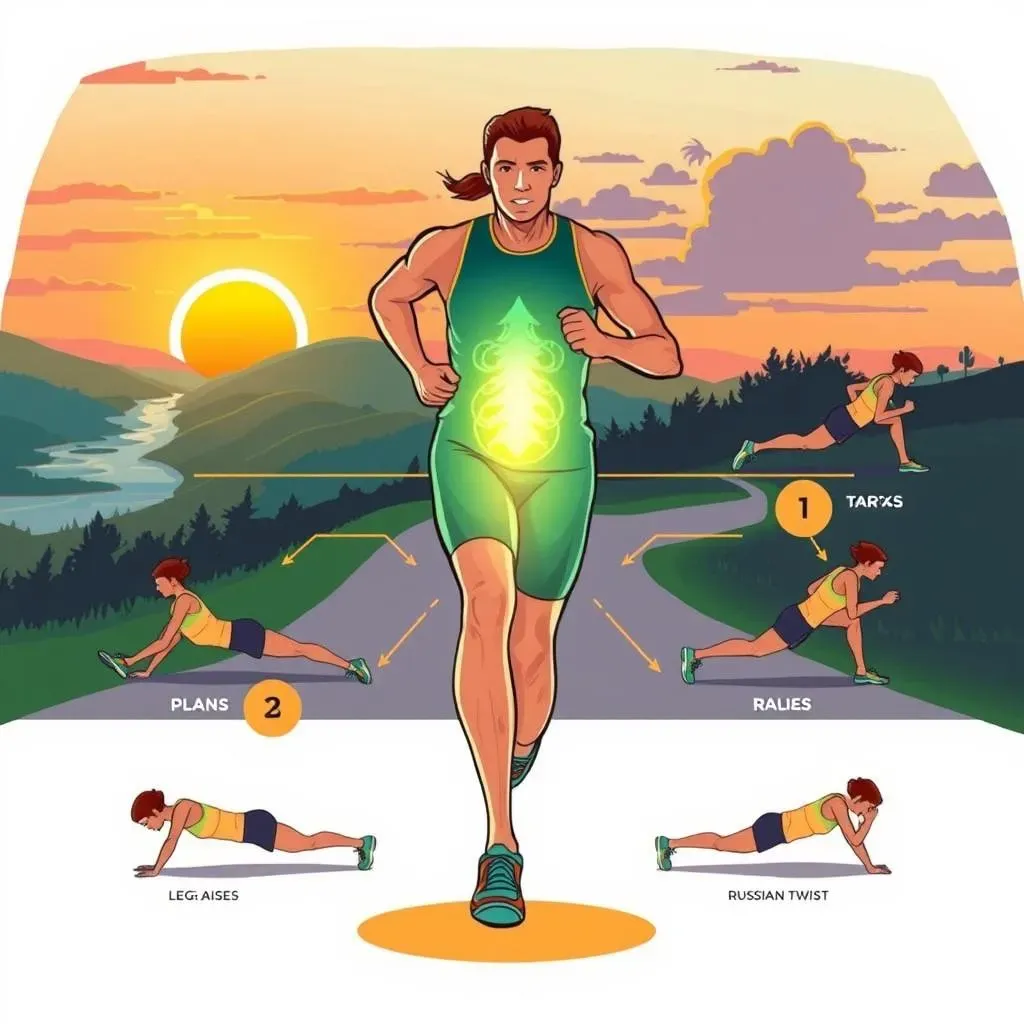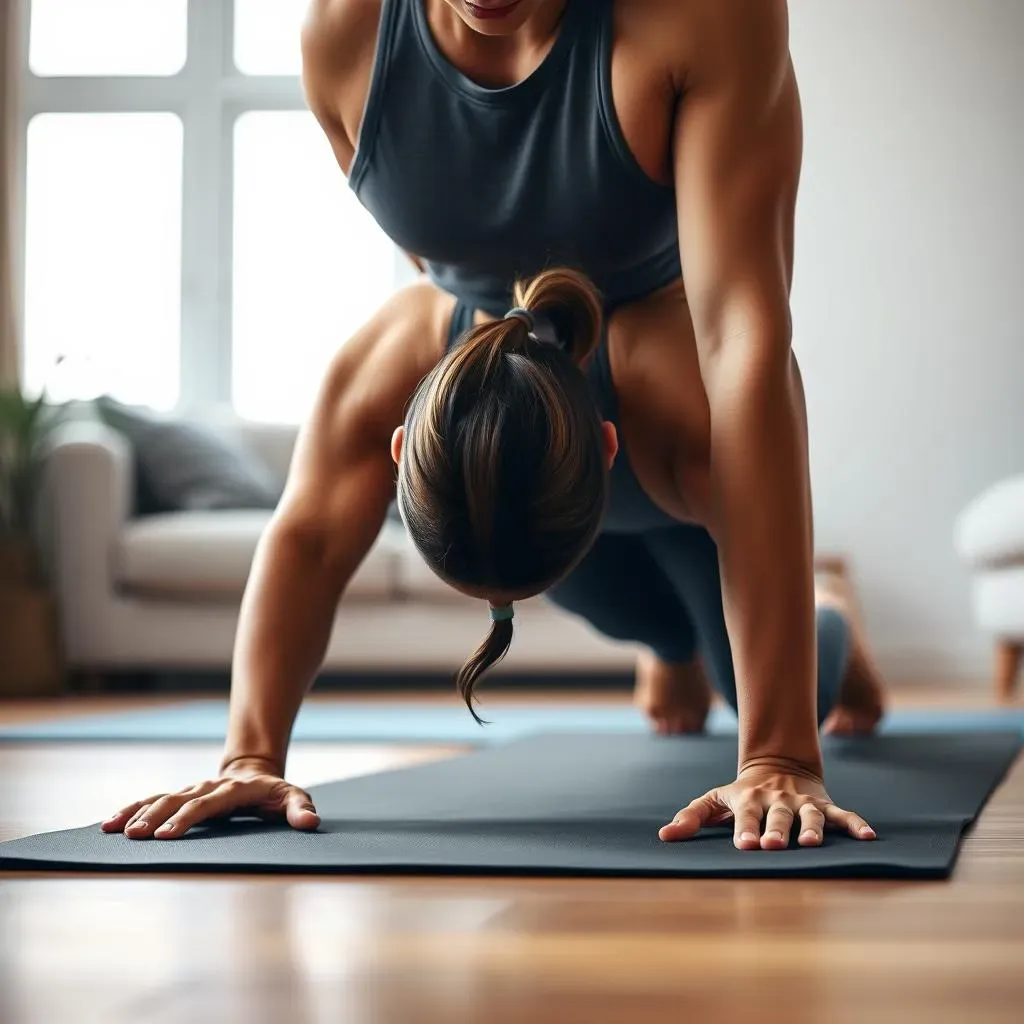Table of Contents
Are you a runner looking to improve your performance and avoid those pesky injuries? You're probably already logging miles, but are you paying attention to your core? A strong core isn't just about having a six-pack; it's the powerhouse behind every stride. Think of your core as the engine of your running machine. When it's weak, you lose power, stability, and risk getting hurt. This article is all about "core workouts at home for runners." We're not talking about endless crunches. Instead, I'll guide you through why a strong core matters for runners, the best exercises you can do without a gym, and how to fit them into your routine. You'll discover how these targeted workouts will not only improve your speed and endurance but also keep you running pain-free. Get ready to unlock the potential of your run with these simple, effective core routines you can do right in your living room. Let’s get started!
Why Runners Need a Strong Core

Why Runners Need a Strong Core
The Powerhouse of Your Run
Okay, let's get real. You might think running is all about your legs, right? Wrong! It's actually your core that's the unsung hero. I like to think of it as the central hub connecting your upper and lower body. A strong core is like a sturdy bridge, ensuring that the power generated by your legs isn't wasted. Without it, you're basically trying to run with a wobbly foundation. Every stride you take, your core muscles work to keep you stable, upright, and efficient. If these muscles are weak, your body will compensate, leading to poor form, wasted energy, and eventually, injuries. It's not just about looking good; it's about running well.
Think of it like this: imagine trying to fire a cannon from a canoe. The canoe would wobble all over the place, right? You'd lose a ton of power. A strong core is like a solid ship that allows your legs to do what they're meant to do—push you forward. It’s the key to transferring energy smoothly, allowing you to run faster and longer, with less effort. This isn’t just some fitness fluff; it's the science of running. Neglecting your core is like neglecting the engine of your car; eventually, it won’t run very well, and it might even break down.
Benefit | Why it Matters |
|---|---|
Improved Running Form | A strong core helps maintain proper posture, reducing wasted movement. |
Increased Efficiency | Efficient energy transfer means you run faster with less effort. |
Injury Prevention | A stable core protects your back and hips from strain and injuries. |
More Than Just Abs
Now, when I say "core," I'm not just talking about your abs. We're talking about a whole team of muscles working together. Your core includes your abs (rectus abdominis, obliques, and transverse abdominis), your lower back muscles (erector spinae), your hip flexors, and even your glutes. These muscles act like a natural corset, keeping your spine stable and protecting you from injury. When all these muscles work in sync, you’ll notice a huge difference in your running performance. It means smoother, more powerful strides and a reduced risk of ending up on the sidelines.
Think of your core as the conductor of an orchestra. Each muscle plays its part, and when they all play in harmony, the result is beautiful. Neglecting even one of these core muscles can throw off the whole performance, leading to imbalances and potential issues. So, when you’re working on your core, remember it’s not just about the front; it’s also about the sides and the back. It’s about building a complete and balanced support system for your entire body. This will not only make you a better runner but also a more resilient one.
Essential Core Exercises for Runners at Home

Essential Core Exercises for Runners at Home
Plank Variations: Your Core's Best Friend
Alright, let's talk about planks. These aren't just about holding a straight line; they're your secret weapon for a stronger core. When I first started, I thought planks were just torture, but now I see them as the cornerstone of my core routine. The beauty of planks is that you can do them anywhere, and there are tons of variations to keep things interesting. Start with a basic plank, making sure your body forms a straight line from head to heels. No sagging hips, please! Then, try forearm planks, side planks, and even plank jacks to really challenge those muscles. It's not just about holding the position; it's about engaging those core muscles the entire time.
I've seen so many runners just go through the motions, but it's the focused engagement that makes the difference. Think about pulling your belly button towards your spine and squeezing your glutes. It's like you're trying to make yourself as tight and stable as possible. Once you get comfortable with the basics, you can start adding in some movement. Try plank walkouts or knee-to-chest movements. These variations not only make the exercise more challenging, but they also mimic the movements you make when you run, making them even more beneficial for your performance. Don't underestimate the power of a good plank; it's the foundation of a strong and stable run.
Plank Type | Focus Area | How to do it |
|---|---|---|
Basic Plank | Overall core stability | Hold a straight line from head to heels, engaging core muscles. |
Forearm Plank | Lower abs and shoulders | Same as basic, but rest on forearms instead of hands. |
Side Plank | Obliques | Balance on one forearm and the side of one foot, keeping body straight. |
Plank Jacks | Cardio and core | Start in a plank, jump feet out and back in, like a jumping jack. |
Glute Bridges and Bird Dogs: Strengthening Your Backside
Now, let’s not forget about your backside! Glute bridges and bird dogs are essential for a well-rounded core routine. Glute bridges are fantastic for strengthening your glutes and lower back, which are crucial for maintaining good posture while running. Start by lying on your back with knees bent and feet flat on the floor. Then, lift your hips towards the ceiling, squeezing your glutes at the top. It's like you're trying to make a straight line from your shoulders to your knees. Try to hold it for a second or two at the peak, and really feel that burn.
Bird dogs, on the other hand, improve your balance and coordination, while also engaging your core. Start on your hands and knees, then extend one arm forward and the opposite leg back. You should feel a nice stretch across your core and into your back. It's not about how high you can lift your limbs, but about maintaining that straight line and keeping your core engaged. These exercises might seem simple, but they are incredibly effective for strengthening the muscles that support your spine and hips, giving you that extra stability that every runner needs. I like to think about it like fine-tuning an engine, each of these exercises is an adjustment that makes the whole machine run smoother.
Creating Your Core Workout Routine at Home

Creating Your Core Workout Routine at Home
Start Simple, Stay Consistent
Okay, so you're ready to build your core routine. That's awesome! I get it, you're probably excited to jump right in, but hold your horses. The key here is to start simple and stay consistent. Don't overwhelm yourself with a bunch of complicated exercises or try to do too much too soon. I know from my own experience, I started with just a few basic planks and glute bridges, and that was enough to get the ball rolling. It's like learning a new language; you don't start with Shakespeare, you start with the alphabet. Begin with 2-3 exercises, like the ones we've discussed, and do them for 2-3 times a week. That's it! The most important thing is to make it a habit, not a chore.
It's better to do a little bit consistently than to go all out for a week and then quit. Think about it, it's like brushing your teeth; you don't brush them for 3 hours one day and then forget about it for the rest of the week. Consistency is key to building strength and seeing results. So, start small, be patient, and focus on making your core workouts a regular part of your life. You’ll be surprised how quickly you progress, and how much better you feel when you run. It's not about perfection, it's about progress, so don't beat yourself up if you miss a day, just get back on track the next day. Remember, it’s a marathon, not a sprint.
Fitting Core Workouts Into Your Day
Now, I know what you're thinking, "I barely have time to run, let alone add in core workouts!" I get it. We're all busy, but the beauty of these at-home core workouts is that they don't need to take up a ton of time. You can easily squeeze them in before or after your run, or even while you're watching TV. Personally, I like to do my core exercises right after my runs, when my muscles are already warmed up. But really, the best time is whenever it works for you. It’s not about finding the perfect time; it’s about making the time.
Don't think you need a fancy gym or a ton of equipment. All you need is a little bit of space and your own body weight. You can do a quick 10-15 minute core routine in your living room, your backyard, or even in a hotel room while you are traveling. It's all about making it work with your lifestyle. There is no one-size-fits-all approach. Experiment with different times and see what feels best for you. The important thing is to make your core workouts a non-negotiable part of your running routine. It's not just about adding something extra, it's about integrating it seamlessly into your life. It’s a game changer, trust me.
Tip | Details |
|---|---|
Warm-up | Start with a few minutes of light cardio, like jogging in place. |
Cool-down | Finish with some stretches to help your muscles recover. |
Listen to your body | Don't push through pain; modify exercises as needed. |
Stay Hydrated | Drink plenty of water before, during, and after your workout. |
Progressing Your Routine
As you get stronger, you'll need to challenge yourself to keep making progress. Don't get stuck doing the same old routine forever; it's time to spice things up. You can do this by increasing the number of reps, the time you hold each exercise, or by adding more difficult variations. For example, if you’re comfortable with a basic plank, try a plank with leg lifts or a side plank with a twist. It's like leveling up in a video game; each time you get stronger, you need to face a new challenge. Don't be afraid to experiment and try new things; it's all part of the journey.
Remember, progress isn't always linear. Some days, you'll feel like a superhero, and other days, you'll feel like you're starting from scratch. That's totally normal. The key is to keep showing up and doing your best. Pay attention to how your body feels and adjust your routine accordingly. It’s a journey, not a destination. It’s about constant improvement and finding new ways to challenge yourself. Don't be afraid to try new exercises or modify old ones to keep your core engaged and your workouts exciting. So, keep pushing yourself, stay curious, and enjoy the process. You got this!
How Core Workouts Improve Your Running and Prevent Injuries

How Core Workouts Improve Your Running and Prevent Injuries
Run Faster, Stronger, Longer
Alright, let's talk about the real magic of core workouts. It’s not just about looking good; it’s about transforming your running experience. When you consistently work on your core, you'll start to notice some major improvements in your runs. A stronger core means better posture, which allows you to run more efficiently. Think about it: when your core is weak, your body tends to slump, which puts extra pressure on your back and hips, and it makes you less aerodynamic, like running with a parachute on your back. With a strong core, you stand taller, your body moves smoother, and your energy isn't wasted on unnecessary movements. It’s like upgrading to a more efficient engine; you get more power with less fuel. You’ll be able to run faster, go longer, and feel less tired at the end of your runs. It's a total game-changer.
Beyond just performance, a strong core is like your personal bodyguard against injuries. When your core muscles are weak, your body has to rely on other muscles to compensate, which can lead to strains, sprains, and other painful issues. A strong core acts like a natural brace, protecting your spine and hips from excessive stress. It’s like building a fortress around your vital organs, keeping them safe and sound. When I started focusing on my core, I noticed a huge difference in how my body felt after a run. No more nagging back pain or sore hips! It’s not just about preventing injuries; it’s about running healthier and feeling better. It’s about enjoying your runs without the fear of something going wrong. It's about investing in your body and your running future.
Benefit | How Core Workouts Help |
|---|---|
Improved Running Economy | A strong core allows for more efficient energy transfer, reducing wasted movement. |
Reduced Risk of Injury | A stable core protects your back, hips, and knees from strain and injuries. |
Enhanced Balance and Stability | A strong core improves your balance, which is essential for maintaining good running form. |
The Ripple Effect of a Strong Core
The benefits of core workouts aren't limited to just your running. A strong core can improve your everyday life as well, it's like the foundation of a building, if the foundation is strong the entire building will be stronger. You'll find that you have better posture, not just when you run, but also when you sit, stand, and move around. This can help reduce back pain, neck pain, and other common aches and pains. I've noticed that I feel more confident and comfortable in my body since I started focusing on my core. It's like I have this internal support system that keeps me feeling strong and stable all day long. It's not just about becoming a better runner; it's about becoming a more resilient and healthier person overall.
I've seen so many runners focus only on their legs and completely ignore their core, and they always end up with injuries or plateau in their performance. It's like trying to build a house without a solid foundation; it might look good for a while, but eventually, it will crumble. Core workouts are the secret weapon that every runner needs. It's the key to unlocking your full potential and enjoying your runs to the fullest. So, don't neglect your core; it's the key to running faster, stronger, and pain-free. It's an investment in your body, your running, and your overall health. Think of your core as your secret weapon; it’s time to unleash it.
